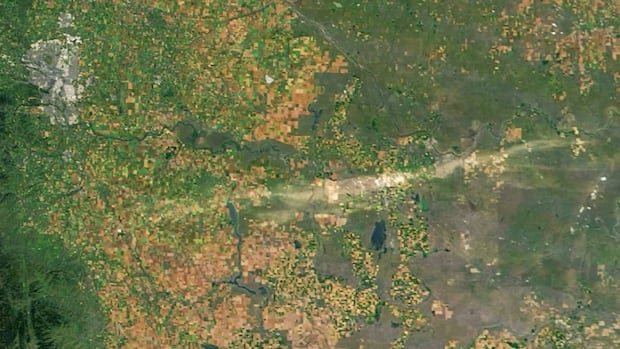Wind and hail that swept through the southern Alberta prairie in the recent past have left behind a significant mark that is visible even from space. The storm, which occurred on August 20, 2025, brought gusts of up to 150 kilometers per hour, causing extensive damage to crops and vegetation over an area spanning from south of Calgary to Saskatchewan. Approximately 425,000 acres of insurable crops, as well as pasture and native grassland, were affected by the storm.
The most severe impact of the storm, described as an epicenter that extended for hundreds of kilometers, resulted in a distinctive “hail scar” that has been captured in satellite images released by NASA. The scar, measuring about 15 kilometers wide and 200 kilometers long, replaces the usual patchwork of green shades with a visible line of damage and soil displacement. The most significant damage was centered north of Brooks, where properties suffered extensive destruction, including demolished home siding, torn corn stalks, overturned irrigation pivots, and stripped asphalt shingles.
Researchers from the Northern Hail Project at Western University conducted a study on the storm’s aftermath, identifying an area 22 kilometers north of Brooks as experiencing the heaviest damage ever documented by the project. The study reported total crop devastation, with grain crops flattened, corn stalks bare, grasslands pulverized, and native shrubs stripped on their western sides.
Cleanup efforts are currently underway, with affected residents and volunteers working diligently to clear debris and restore the damaged areas. Farmers are assessing the remaining crops, salvaging what they can for livestock feed or plowing under the severely damaged fields. Ranchers are facing challenges as the storm flattened grass and exposed root systems, potentially leading to reduced grazing capacity for several years until the pasture regenerates.
The impact of the storm on agriculture and livestock in the region is significant, with millions of dollars in crop damage expected. Recovery efforts are ongoing, with experts emphasizing the need for careful management of the affected areas to facilitate regrowth and restoration. While the land may recover relatively quickly in terms of satellite imagery, the localized damage can have long-lasting effects that require strategic planning and monitoring for successful rehabilitation.
Despite the resilience of the prairie landscape, the aftermath of the storm serves as a stark reminder of the vulnerability of agricultural and natural ecosystems to extreme weather events. Farmers and ranchers are facing the daunting task of rebuilding and restoring their lands, with the hope of overcoming the challenges posed by this destructive hailstorm.
